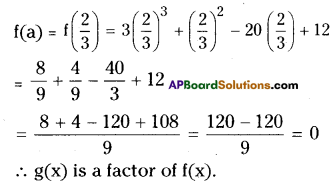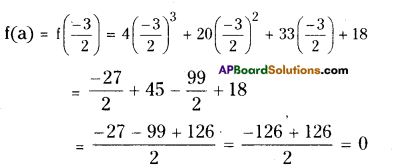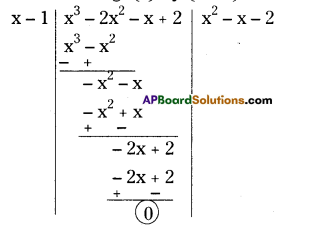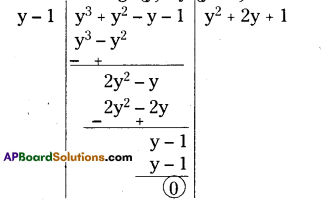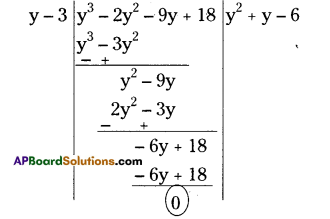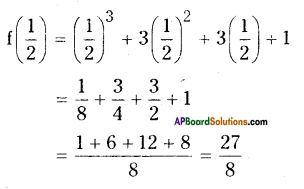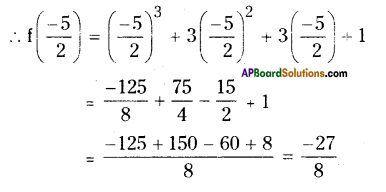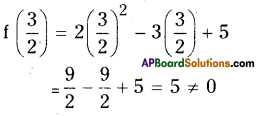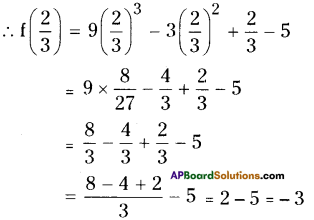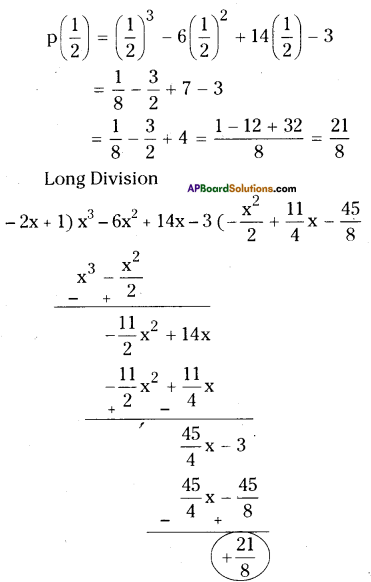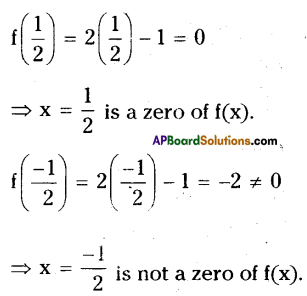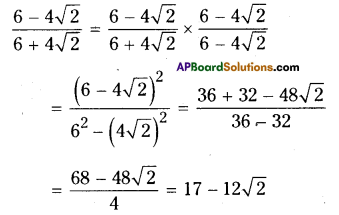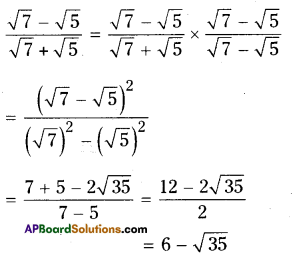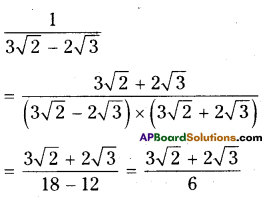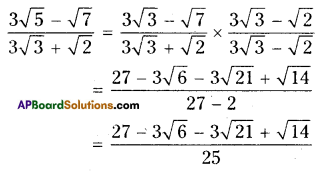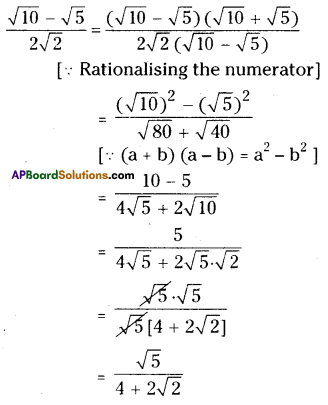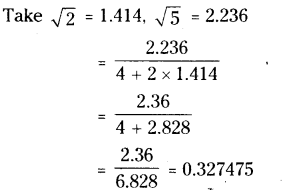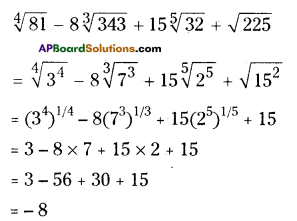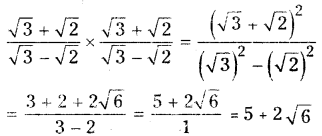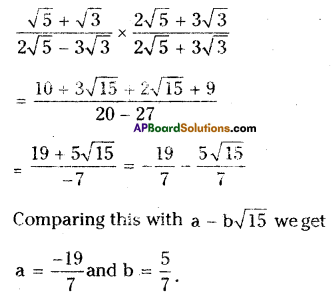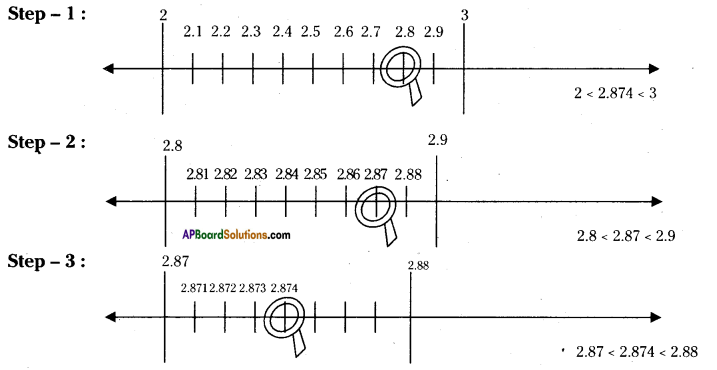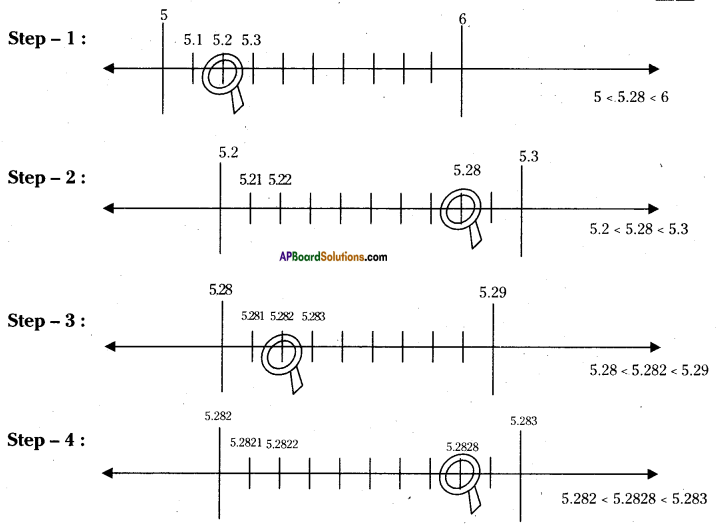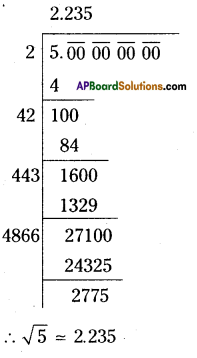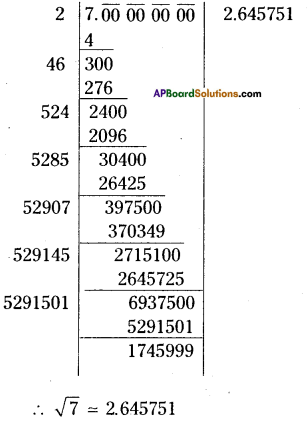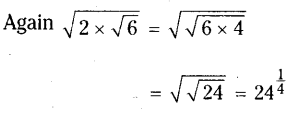AP State Syllabus AP Board 9th Class Maths Solutions Chapter 2 Polynomials and Factorisation Ex 2.5 Textbook Questions and Answers.
AP State Syllabus 9th Class Maths Solutions 2nd Lesson Polynomials and Factorisation Exercise 2.5
Question 1.
Use suitable identities to find the following products.
i) (x + 5) (x + 2)
Solution:
(x + 5) (x + 2)
= x2 + (5 + 2)x + 5 x 2
[ ∵ (x + a) (x + b) = x2 + (a + b) x + ab]
= x2 + 7x + 10
![]()
ii) (x – 5) (x – 5)
Solution:
(x – 5) (x – 5)
= (x – 5)2 = x2 – 2(x) (5) + 52
[ ∵(x – y)2 = x2 – 2xy + y2]
= x2 – 10x + 25
iii) (3x + 2) (3x – 2)
Solution:
(3x + 2) (3x – 2) = (3x)2 – (2)2
[∵ (x + y) (x – y) =x2 – y2]
= 9x2 – 4
iv) \(\left(x^{2}+\frac{1}{x^{2}}\right)\left(x^{2}-\frac{1}{x^{2}}\right)\)
Solution:

![]()
v) (1 + x) (1 + x)
Solution:
(1 + x) (1 + x)
= (1 + x)2 = 12 + 2 (1) (x) + x2
[∵(x + y)2 = x2 + 2xy + y2]
= 1 + 2x + x2
Question 2.
Evaluate the following products with¬out actual multiplication.
i) 101 x 99
Solution:
101 x 99
= (100 + 1) (100 – 1)
= 1002 – 12
= 10000 – 1
= 9999
ii) 999 x 999
Solution:
999 x 999
= 9992
= (1000 – 1)2
= 10002 – 2 x (1000) x 1 + 12
= 1000000-2000 + 1
= 998001
![]()
iii) \(50 \frac{1}{2} \times 49 \frac{1}{2}\)
Solution:
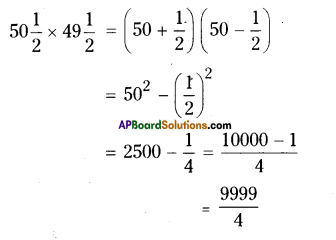
iv) 501 x 501
Solution:
501 x 501
= (500 + 1) (500 + 1)
= (500 + 1)2
= 5002 + 2 x (500) x 1 + 12
= 250000 + 1000 + 1 = 251001
v) 30.5 x 29.5 = (30 + 0.5) (30 – 0.5)
= 302 – (0.5)2
= 900 – 0.25
= 899.75
Question 3.
Factorise the following using appro-priate identities.
i) 16x2 + 24xy + 9y2
Solution:
16x2 + 24xy + 9y2
= (4x)2 + 2 (4x) (3y) + (3y)2
= (4x + 3y)2 = (4x + 3y) (4x + 3y)
[ ∵ (x + y)2 = x2 + 2xy + y2]
ii) 4y2 – 4y + 1
Solution:
4y2 – 4y + 1
= (2y)2 – 2 (2y) (1) + (1)2
[ ∵ (x -y)2 = x2 – 2xy + y2]
= (2y -1)2 = (2y – 1) (2y-1)
![]()
iii) \(4 x^{2}-\frac{y^{2}}{25}\)
Solution:
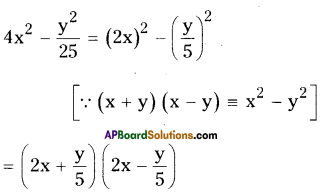
iv) 18a2 – 50
Solution:
18a2 – 50 = 2 (9a2 – 25)
= 2[(3a)2 – (5)2]
[ ∵ x2 – y2 = (x + y) (x – y)]
= 2 (3a + 5) (3a – 5)
v) x2 + 5x + 6
Solution:
x2 + 5x + 6 = x2 + (3 + 2) x + 3 x 2
[ ∵ (x + a) (x + b) = x2 + (a + b) x + a . b]
= (x + 3) (x + 2)
vi) 3p2 – 24p + 36
Solution:
3p2 – 24p + 36
= 3[p2 – 8p + 12]
= 3[p2 + (- 6 – 2)p + (- 6) (- 2)]
[ ∵ (x + a) (x + b) = x2 + (a + b) x + ab]
= 3 (p – 6) (p – 2)
Question 4.
Expand each of the following, using suitable identities.
i) (x + 2y + 4z)2
(x + 2y + 4z)2 = (x)2 + (2y)2 + (4z)2 + 2(x) (2y) + 2 (2y) (4z) + 2 (4z) (x)
[ ∵ (x + y + z)2 = x2 + y2 + z2 + 2xy + 2yz + 2zx]
= x2 + 4y2 + 16z2 + 4xy + 16yz + 8zx
![]()
ii) (2a – 3b)3
Solution:
(2a – 3b)3 = (2a)3 – 3 (2a)2 (3b) + 3 (2a) (3b)2 – (3b)3
[ ∵ (a – b)3 = a3 – 3a2b + 3ab2 – b3]
= 8a3 – 3(4a2) (3b) + 3 (2a) (9b2) – 27b3
= 8a3 – 36a2b + 54ab2-27b3
(or)
∵ (a – b)3 = a3 – b3– 3ab (a – b)]
= (2a)3 – (3b)3 – 3(2a) (3b) (2a – 3b)
= 8a3 – 27b3 – 18ab (2a – 3b)
iii) (- 2a + 5b – 3c)2
Solution:
(- 2a + 5b – 3c)2
= (- 2a)2 + (5b)2 + (- 3c)2 + 2 (- 2a) (5b) + 2 (5b) (- 3c) + 2 (- 3c) (- 2a)
= 4a2 + 25b2 + 9c2 – 20ab – 30bc + 12ca
[ ∵ (x + y + z)2 = x2 + y2 + z2 + 2xy +2yz +2za]
iv) \(\left[\frac{a}{4}-\frac{b}{2}+1\right]^{2}\)
Solution:

v) (p + 1)3
Solution:
(p + 1)3
= (P)3 + 3 (p)2 (1) + 3 (p) (1)2 + (1)3
[ ∵ (x + y)3 = x3 + 3x2y + 3xy2 + y3]
= p3 + 3p2 + 3p + 1
![]()
vi) \(\left(x-\frac{2}{3} y\right)^{3}\)
Solution:
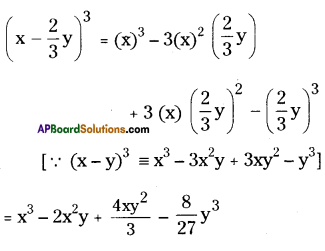
Question 5.
Factorise
i) 25x2 + 16y2 + 4z2 – 40xy + 16yz – 20xz
Solution:
25x2 + 16y2 + 4z2 – 40xy + 16yz – 20xz
= (5x)2 + (- 4y)2 + (- 2z)2 + 2(5x) (- 4y) + 2 (- 4y) (- 2z) + 2 (- 2z) (5x)
= (5x – 4y – 2z)2 = (- 5x + 4y +, 2z)2
ii) 9a2 + 4b2 + 16c2 + 12ab – 16bc – 24ca
Solution:
9a2 + 4b2 + 16c2 + 12ab – 16bc -24ca
= (3a)2 + (2b)2 + (- 4c)2+ 2 (3a) (2b) + 2 (2b) (- 4c) + 2(- 4c) (3a)
= (3a + 2b – 4c)2
Question 6.
If a + b + c = 9 and ab + be + ca = 26, find a2 + b2 + c2.
Solution:
Given that a + b + c = 9
Squaring on both sides,
(a + b + c)2 = 92
⇒ a2+ b2 + c2+ 2 (ab + be + ca) = 81 ⇒ a2 + b2 + c2 = 81 – 2 (ab + be + ca)
(by problem)
= 81 – 2 x 26
= 81 – 52 = 29
![]()
Question 7.
Evaluate the following by using suit¬able identities. m EachgM)
i) (99)3
Solution:
(99)2 = (100 – 1)3
= 1003 – 3 (100)2 (1) + 3 (100) (1)2 – 13
[ ∵ (x – y)3 = x3 – 3x2y + 3xy2 + y3]
= 1000000 – 30000 + 300 – 1
= 970299
ii) (102)3
Solution:
(102)3 = (100 + 2)3
= 1003 + 3 (100)2 (2) + 3 (100) (2)2 + 23
[ ∵ (x + y)3 = x3 + 3x2y + 3xy2 + y3]
= 1000000 + 60000 + 1200 + 8
= 1061208
iii) (998)3
Solution:
(998)3 =(1000 – 2)3
[ ∵ (x – y)3 = x3 – 3x2y + 3xy2 – y3] = 10003– 3(1000)2(2) + 3(1000)(2)2– 23
= 1000000000 – 6000000 + 12000 – 8
= 994011992
iv) (1001)3
Solution:
(1001)3 = (1000 + 1)3 .
[ ∵ (x + y)3 = x3 + 3x2y + 3xy2 + y3] = 10003 + 3(1000)2(1) + 3(1000) (1)2 + 13
= 1000000000 + 3000000 + 3000 + 1
= 1003003001
![]()
Question 8.
Factorise each of the following.
i) 8a3 + b3 + 12a2 b + 6ab2
Solution:
8a3 + b3 + 12a2 b + 6ab2
= (2a)3 + (b)3 + 3 (2a)2 (b) + 3 (2a) (b)2
= (2a + b)3
ii) 8a3 – b3 – 12a2 b + 6ab2
Solution:
8a3 – b3 – 12a2 b + 6ab2
= (2a)3 – (b)3 – 3 (2a)2 (b) + 3 (2a) (b)2
= (2a – b)3
iii) 1 – 64a3 -12a + 48a2
Solution:
1 – 64a3 – 12a + 48a2
= (1)3 – (4a)3 – 3(1)2 (4a) + 3(1) (4a)2
= (1 – 4a)3
iv) \(8 p^{3}-\frac{12}{5} p^{2}+\frac{6}{25} p-\frac{1}{125}\)
Solution:
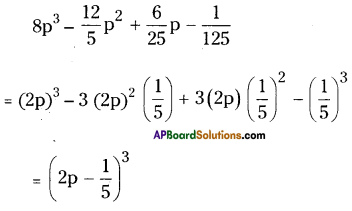
![]()
Question 9.
Verify i) x3 + y3 = (x + y) (x2 – xy + y2);
ii) x3 – y3 = (x – y) (x2 + xy + y2)
Using some non-zero positive integers and check by actual multiplication. Can you
call these as identities ?
i) x3 + y3 = (x + y) (x2 – xy + y2)
Solution:
Given x3 + y3 = (x + y) (x2 – xy + y2)
L.H.S = x3 + y3
R.H.S = (x + y) (x2 – xy + y2)
= x (x2 – xy + y2) + y (x2 – xy + y2)
= x3 -x2y + xy2 + x2y – xy2 + y3
= x3 + y3
= L.H.S
∴ L.H.S = R.H.S
Take x = 3, y = 2
L.H.S = 33 + 23 = 27 + 8 = 35
R.H.S = (3 + 2) (32 – 3 x 2 + 22)
= 5 x (9 – 6 + 4)
= 5 x 7 = 35
∴ L.H.S = R.H.S
ii) x3 – y3 = (x – y) (x2 + xy + y2)
Solution:
Given that x3 – y3 = (x – y) (x2 + xy + y2)
L.H.S = x3 – y3
R.H.S = (x – y) (x2 + xy + y2)
= x (x2 + xy + y2) – y (x2 + xy + y2)
= x3 + x2y + xy2 – x2y – xy2 – y3
= x3 – y3= L.H.S
![]()
L.H.S = 33 – 23 = 27 – 8 = 19
R.H.S = (3 – 2) (32 + 3 x 2 + 22)
= 1 x (9 + 6 + 4)
= 1 x 19 = 19
∴ L.H.S = R.H.S
We can call the above two expressions as identities
Question 10.
Factorise by using the above results (identities).
i) 27a3 + 64b3
Solution:
27a3+ 64b3 = (3a)3 + (4b)3
= (3a + 4b) {(3a)2 – (3a) (4b) + (4b)2}
= (3a + 4b) (9a2 – 12ab + 16b2)
ii) 343y3 – 1000
Solution:
343y3 – 1000 = (7y)3 – (10)3
= (7y – 10) [(7y)2 + (7y) (10) + (10)2]
= (7y – 10) (49y2 + 70y + 100)
![]()
Question 11.
Factorise 27x3 + y3 + z3 – 9xyz using identity.
Solution:
Given 27x3 + y3 + z3 – 9xyz
= (3x)3 + (y)3 + (z)3 – 3 (3x) (y) (z)
= (3x + y + z)
[(3x)2 + y2 + z2 – (3x) (y) – (y) (z) – (z) (3x)]
[ ∵ (x3 + y3 + z3 – 3xyz = (x + y + z) (x2 + y2 + z2– xy – yz – zx)
= (3x + y + z) (9x2 + y2 + z2 – 3xy – yz – 3xz)
Question 12.
Verify that x3+ y3 + z3 – 3xyz = 1/2 (x + y + z) [(x – y)2 + (y – z)2 + (z – x)2 ]
(OR)
Verify that
p3 + q3 + r3 – 3pqr = 1/2 (p + q + r)
[(p – q)2 + (q – r)2 + (r – p)2]
Solution:
Given x3+ y3 + z3 – 3xyz = 1/2 (x + y + z) [(x – y)2 + (y – z)2 + (z – x)2 ]
R-H.S = 1/2 (x + y + z) [(x – y)2 + (y – z)2+ (z – x)2]
= 1/2 (x + y + z) [x2 + y2 – 2xy + y2 + z2 – 2yz + z2 + x2 – 2xz]
= 1/2 (x + y + z) [2x2 + 2y2 + 2z2 – 2xy – 2yz – 2zx]
= 1/2 (x + y + z) (2) [x2 + y2 + z2 – xy – yz – zx]
= (x + y + z) (x2 + y2 + z2 – xy – yz – zx)
= L.H.S
Hence proved.
![]()
Question 13.
If x + y + z = 0, show that x3 + y3 + z3 = 3xyz
Solution:
Given x + y + z = 0
To prove x3 + y3 + z3 = 3xyz
We have an identity
(x + y + z) (x2 + y2 + z2 – xy – yz – zx)
= x3 + y3 + z3 – 3xyz
Substituting x + y + z = 0in the above equation, we get
0 x (x2 + y2 + z2 -xy-yz-zx)
= x3 + y3 + z3 – 3xyz
⇒ x3 + y3 + z3 – 3xyz = 0
⇒ x3 + y3 + z3 = 3xyz
Question 14.
Without actual calculating the cubes, find the value of each of the following.
i) (- 10)3 + 73 + 33
Solution:
Given (-10)3 + 73 + 33
Sum of the bases = -10 + 7 + 3 = = 0
∴ (- 10)3 + 73 + 33
= 3 (- 10) x (7) x 3
= -630
[ ∵ x + y + z = 0 then x3 + y3 + z3 = 3xyz]
ii) (28)3 + (- 15)3 + (- 13)3
Solution:
Given (28)3 + (- 15)3+ (- 13)3
Sum of the bases = 28 + (- 15) + (- 13) = 0
∴ (28)3 + (- 15)3 + (- 13)3
= 3 x 28 x (- 15) x (- 13)
= 16380
![]()
iii) \(\left(\frac{1}{2}\right)^{3}+\left(\frac{1}{3}\right)^{3}-\left(\frac{5}{6}\right)^{3}\) read it as \(\left(\frac{1}{2}\right)^{3}+\left(\frac{1}{3}\right)^{3}+\left(\frac{-5}{6}\right)^{3}\)
Solution:

iv) (0.2)3 – (0.3)3 + (0.1)3
Solution:
Given that (0.2)3 – (0.3)3 + (0.1)3
= (0.2)3 + (- 0.3)3 + (0.1)3
Sum of the bases = 0.2 – 0.3 + 0.1 = 0
∴ (0.2)3 + (-0.3)3 + (0.1)3
= 3 x (0.2) (- 0.3) (0.1)
= -0.018
![]()
Question 15.
Give possible expressions for the length and breadth of the rectangle whose area is given by
i) 4a2 + 4a – 3
Given that area = 4a2 + 4a – 3
= 4a2 + 6a – 2a – 3
= 2a (2a + 3) – 1 (2a + 3)
= (2a – 1) (2a + 3)
∴ Length = (2a + 3); breadth = (2a – 1).
ii) 25a2 – 35a + 12
Solution:
Given that area = 25a2 – 35a +12
= 25a2 – 20a – 15a + 12
= 5a (5a – 4) – 3 (5a – 4)
= (5a – 4) (5a – 3)
∴ (5a – 4) (5a – 3) are the length and breadth.
Question 16.
What are the possible polynomial expressions for the dimensions of the cuboids whose volumes are given below ?
i) 3x3 – 12x
Solution:
Volume = 3x3 – 12x
= 3x (x2 – 4)
= 3x (x + 2) (x – 2) are the dimensions.
![]()
ii) 12y2 + 8y – 20
Solution:
Given that volume = 12y2 + 8y – 20
= 4 (3y2 + 2y – 5)
= 4 [3y2 + 5y – 3y – 5]
= 4 [y (3y + 5) – 1 (3y + 5)]
= 4 (3y + 5) (y – 1)
Hence 4, (3y + 5) and (y – 1) are the dimensions.
Question 17.
Show that if 2 (a2 + b2 ) = (a + b)2 then a = b
Solution:
Given that 2 (a2 + b2 ) = (a + b)2
To prove a = b
As 2 (a2 + b2 ) = (a + b)2
We have
2a2 + 2b2 = a2 + 2ab + b2
2a2 – a2 + 2b2 – b2 = 2ab
a2 + b2 = 2ab
This is possible only when a = b
∴ a = b
